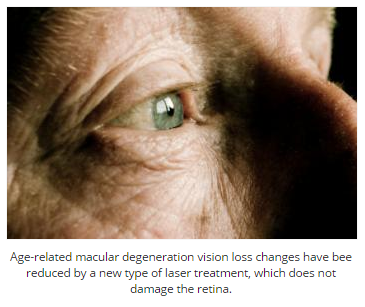A new type of laser treatment has the potential to slow progression of age-related macular degeneration – a major cause of vision loss – without damaging the retina.
This was the conclusion of a study from the University of Melbourne in Australia, published in The FASEB Journal.
Erica Fletcher, an associate professor in Melbourne’s Department of Anatomy and Neuroscience, and colleagues examined the effectiveness of a new low-impact, low-energy, laser treatment for patients with early age-related macular degeneration (AMD).
They found that, unlike other laser treatments, the “nanosecond laser” they tested did not damage the retina – the tissue at the back of the eye that contains light-detecting cells.
Prof. Fletcher says theirs is the first study to describe how the new laser treatment may improve eye health in patients with AMD.
AMD is a painless eye condition that gradually results in loss of central vision. According to the Centers for Disease Control and Prevention (CDC), it is the leading cause of permanent impairment of fine or close-up vision – for example as needed for reading – among people aged 65 years and older.
Estimates suggest about 1.8 million Americans aged 40 and over have AMD and another 7.3 million are at risk of developing it.
In Australia, where the study took place, AMD is responsible for 48% of severe vision loss, with an estimated 17,700 new cases each year.
New laser treatment reduced drusen and thickness of Bruch’s membrane
Examination of the back of the eye in the early stages of AMD reveals the presence of small fatty deposits called drusen, and a thickening of a thin layer of tissue called Bruch’s membrane. As these features worsen, they slowly destroy the central part of the retina.
The study shows that the nanosecond laser can reduce drusen and thin the Bruch’s membrane without damaging the structure of the retina.
For the study, the researchers undertook several tests and experiments. For example, one test involved 50 patients with AMD who had a single session of nanosecond laser treatment and were followed up 2 years later. Eye exams showed their drusen load – compared with a similar group of untreated patients – was reduced.
A test on mice with thickened Bruch’s membrane that received the laser treatment showed the membrane was thinner 3 months after treatment.
New laser treatment did not damage the retina
To detect the new laser’s effect on the retina, the researchers carried out tests on human and mouse eyes – for example using an approach called “immunohistochemistry” that can detect small changes in tissue structure.
Commenting on their study, the researchers say:
“Nanosecond laser resolved drusen independent of retinal damage and improved BM [Bruch’s membrane] structure, suggesting this treatment has the potential to reduce AMD progression.”
Prof. Fletcher says the findings “suggest treating people with AMD with this new nanosecond laser reduces signs of the disease.”
“Importantly,” she adds, “unlike other lasers currently used to treat eye disease, the nanosecond laser does not result in damage to the sensitive retina.”
The researchers also found evidence that treating one eye with the nanosecond laser can have positive effects in the other eye, raising the possibility that one treatment may be sufficient to treat disease in both eyes.
Another leading cause of blindness is glaucoma, where fluid builds up in the eye, putting pressure on the optic nerve. The condition can be treated, but there is currently no cure.
However, in September 2014, Medical News Today learned of a new study that may point to a cure for glaucoma. The answer may lie in targeting “stiff cells” that impede fluid drainage and cause pressure to build up inside the eye.
Written by Catharine Paddock PhD
http://www.medicalnewstoday.com/articles/285756.php

